In Vitro Diagnostic Market Size
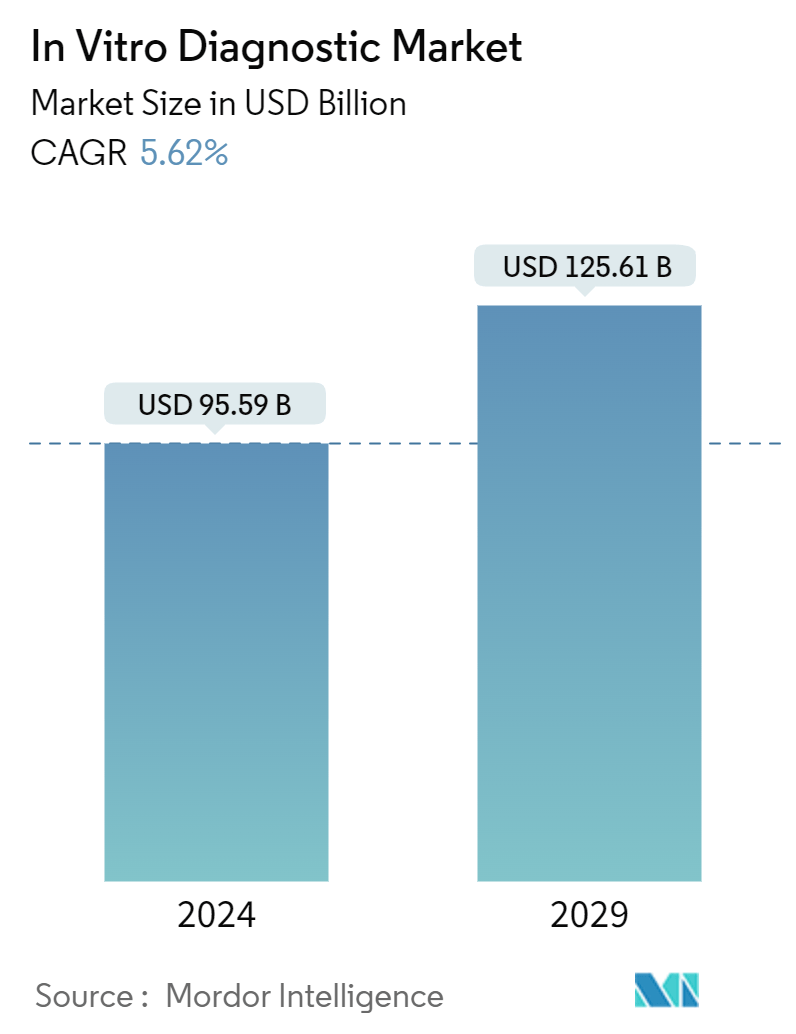
| Study Period | 2021 - 2029 |
| Market Size (2024) | USD 95.59 Billion |
| Market Size (2029) | USD 125.61 Billion |
| CAGR (2024 - 2029) | 5.62 % |
| Fastest Growing Market | Asia Pacific |
| Largest Market | North America |
Major Players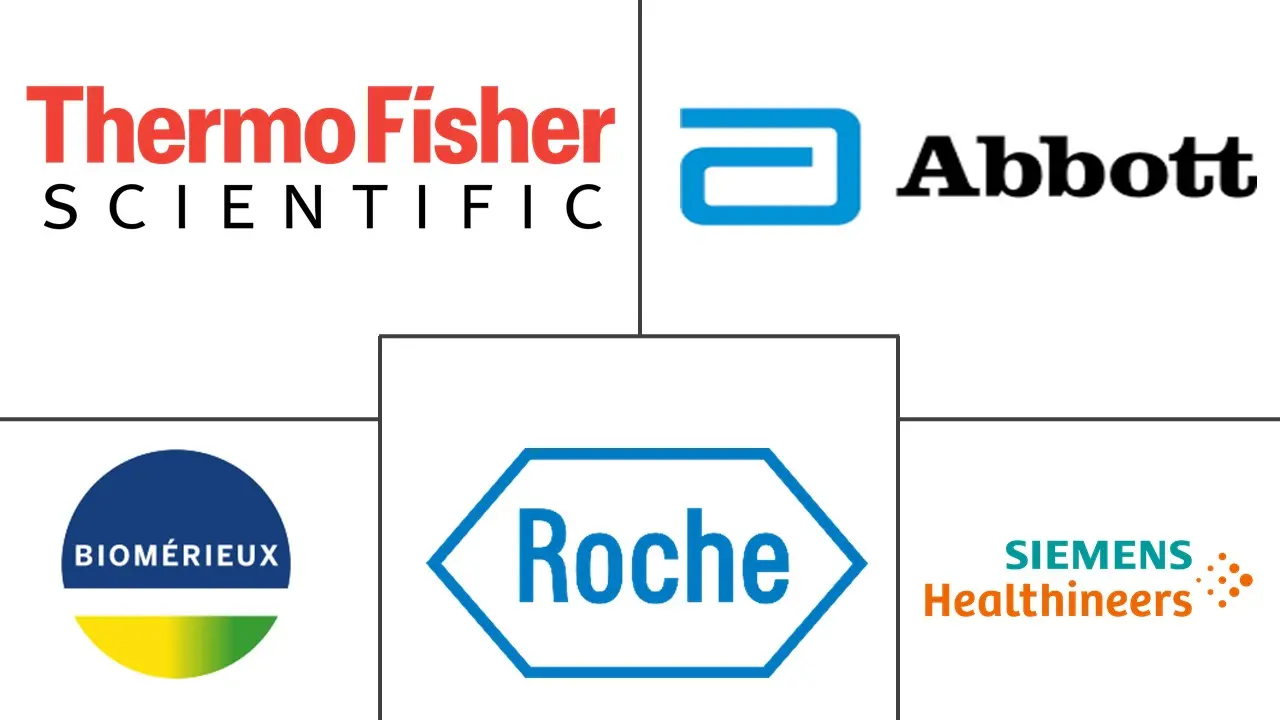
*Disclaimer: Major Players sorted in no particular order |
In Vitro Diagnostic Market Analysis
The In Vitro Diagnostic Market size is estimated at USD 95.59 billion in 2024, and is expected to reach USD 125.61 billion by 2029, growing at a CAGR of 5.62% during the forecast period (2024-2029).
The growth of the in vitro diagnostics (IVD) market is attributed to the high prevalence of chronic and infectious diseases, increasing use of point-of-care (POC) diagnostics, advanced technologies in in vitro diagnostic products, and the growing awareness and acceptance of personalized medicine and companion diagnostics.
The growing burden of chronic diseases fuels the need for in-vitro diagnostics solutions to improve early diagnosis of the condition, which is expected to contribute to market growth. For instance, in December 2023, the Australian Institute of Health and Welfare (AIHW) mentioned that the risk of coronary heart disease increases significantly with age and is prevalent in around 1 in 9 adults (11%) aged 75 years and above in Australia. In addition, in July 2023, the United Nations Office for the Coordination of Humanitarian Affairs (OCHA) reported that around 39 million individuals were infected with HIV in 2022 worldwide. The high incidence of chronic diseases is increasing the demand for substantial diagnostic procedures, which, in turn, is expected to drive the market over the forecast period.
The use of IVD products with advanced technologies increases their adoption rate and contributes to industry growth. There has been a paradigm shift from traditional diagnostics to a new generation of diagnostics that work at the gene level. This was made possible by including advanced technologies, such as genetic testing, molecular diagnostics, polymerase chain reaction (PCR), and next-generation sequencing (NGS) in the IVD platform. For instance, in June 2023, Deyser launched genetic testing solutions, such as LynchFAP and Devyser BRCA PALB2, to analyze genes like PMS2 and nine other associated genes with Lynch syndrome and breast and ovarian cancer. These kits are equipped with next-generation sequencing (NGS) technology that offers an analysis of genes and improves the diagnosis of hereditary cancer syndromes. This is expected to enhance its adoption and propel market growth over the forecast period.
Additionally, market players incorporate strategic initiatives such as product launches, which will lead to an increase in the accessibility of the products, and thus, drive market growth. For instance, in November 2023, Roche launched the Light Cycler PRO System, incorporating advanced qPCR technology to support clinical diagnostics and research. This advanced system improves performance and usability to address the needs and gaps between translational research and in vitro diagnostics. Similarly, in June 2022, Agilent Technologies launched IVD-compliant instruments, kits, and reagents to comply with the new European Union IVDR regulation.
Therefore, owing to the market trends such as the rising prevalence of chronic diseases and infectious disorders, coupled with advanced technologies in in vitro diagnostics products, the market anticipated to grow over the forecast period. However, the stringent regulations regarding product approvals and cumbersome reimbursement procedures are a few factors expected to restrain the market growth over the forecast period.
In Vitro Diagnostic Market Trends
Reagents are Expected to Witness Significant Growth Over the Forecast Period
The reagents segment of the market includes chemical, biological, or immunological components, solutions, or preparations intended to be used by companies during the in-vitro diagnosis process. Developments such as the rising prevalence of diseases, strategic initiatives taken by market players, and product launches are expected to boost market growth.
Additionally, the industry data shows that with the growing burden of chronic diabetes worldwide, the demand for in-vitro diagnostics increases, which, in turn, is expected to propel the growth of reagents that are used in various testing procedures. For instance, in June 2023, according to the Institute for Health Metrics and Evaluation, around half a billion individuals have diabetes globally. By 2050, the number is expected to reach 1.3 billion. The increase in the population affected by chronic diseases, who require frequent clinical tests for monitoring their conditions, is expected to boost the growth rate of the reagents segment over the forecast period.
Market players are focusing on strategic activities such as new product launches and acquisitions, which are further expected to fuel the availability of reagents in the global market. For instance, in December 2023, Sysmex Corporation expanded the sales of its reagents used for blood testing to determine amyloid beta (Aβ) accumulation in the brain responsible for Alzheimer's disease to Europe. Thus, by expanding the availability of its reagents, including HISCL β-Amyloid 1-42 and 1-40 assay kits, to Europe, the company has been focusing on improving its immunohistochemistry testing business across the region.
Similarly, in October 2023, Alfa Chemistry launched three IVD products for laboratory use, adding to its already diverse range of biological reagents. Additionally, in March 2022, Medix Biochemica completed the acquisition of myPOLS Biotec GmbH to expand its portfolio of IVD raw materials and increase its selection of reagents for molecular diagnostics. This acquisition helped increase the company's global presence and provide customers with even more advanced scientific and technological capabilities in molecular diagnostics.
Therefore, as per the industry trends, the aforementioned factors, such as the rising burden of chronic diseases and market players engaging in acquisitions and other strategies to boost their IVD reagent sales, are expected to propel the segment over the forecast period.
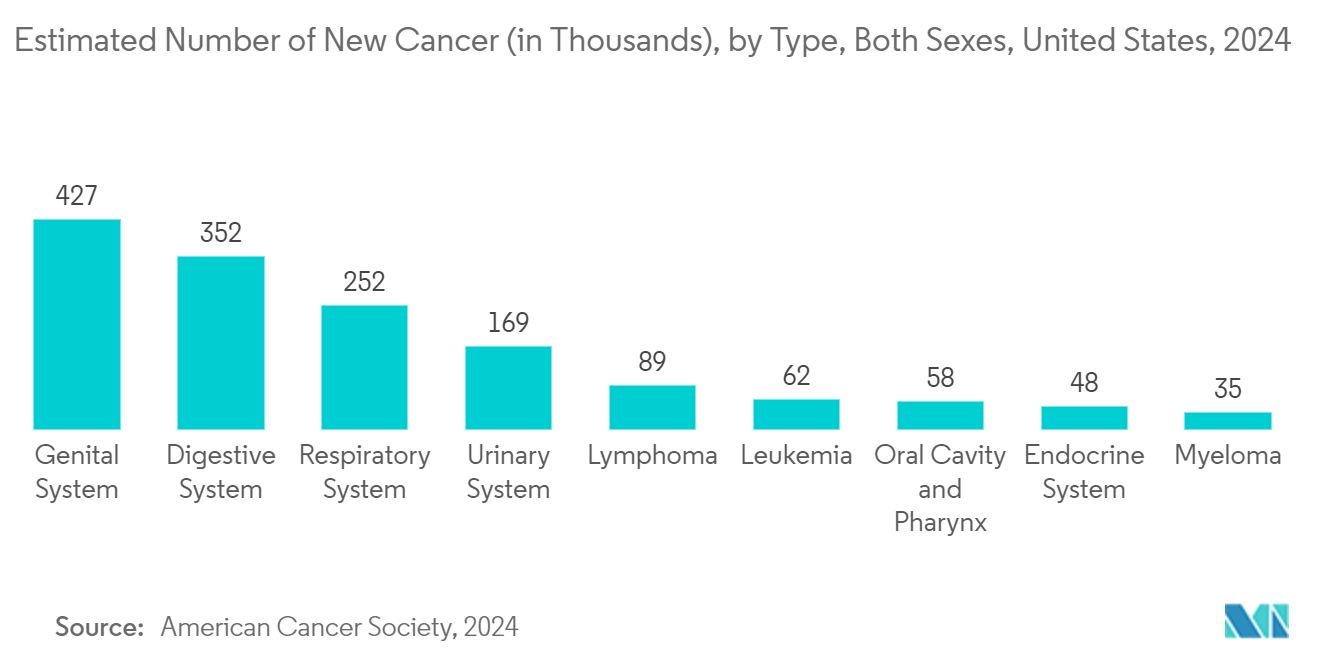
North America is Expected to Hold a Significant Share in the In-Vitro Diagnostics Market Over the Forecast Period
North America has been registering significant growth in the market for IVDs, and it is expected to continue growing over the forecast period. The region is expected to increase its market share owing to the well-established healthcare industry and the rising prevalence of chronic diseases. The United States holds most of the market in North America, owing to rising healthcare expenditure and the rapid adoption of point-of-care testing and companion diagnostics.
The growing burden of chronic diseases boosts the need for in vitro diagnostic testing to diagnose and monitor medical conditions. For instance, in January 2023, according to a study published in Frontiers in Public Health, by 2050, around 142.66 million people aged 50 years and above are expected to suffer from at least one chronic disease in the United States.
Additionally, according to the American Cancer Society, in January 2024, it was estimated that more than 2 million cancer cases would be diagnosed in the United States in 2024 compared to 1.9 million in 2023. Moreover, people with chronic conditions are the most frequent users of healthcare facilities in the United States and account for the most hospital admissions and prescription filling. Thus, the high burden of the target and chronic diseases further fuels the demand for early diagnostic tests in the country. Hence, such factors are expected to drive the growth of the market in the United States over the forecast period.
As per market data, the growing number of product launches in the region and the high concentration of key players in North America are significant factors driving market growth. For instance, in July 2023, Siemens Healthineers launched the Atellica CI analyzer, which received approval from the Food and Drug Administration for immunoassay and clinical chemistry testing. It enables laboratories to manage labor shortage challenges with improved turnaround time, predictability, reporting capability, and safety.
Thus, factors such as the growing burden of chronic diseases and technological advancements in in vitro diagnostic products boost their adoption and contribute to market growth in the region.
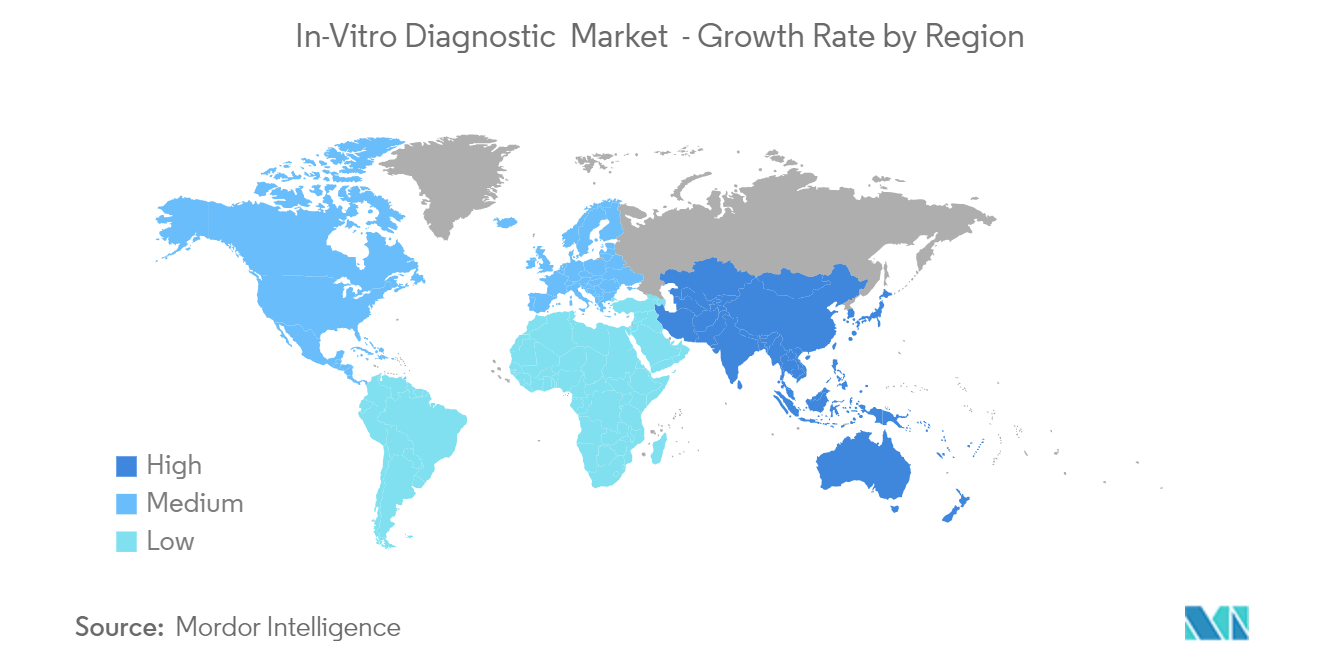
In-Vitro Diagnostic Industry Overview
The in vitro diagnostic market is fragmented in nature due to the presence of several companies operating globally as well as regionally. Market players are adopting various approaches comprising mergers and acquisitions, partnerships, and new product launches. A few of the largest companies are making substantial investments and integrating advanced technologies to expand production and maximize their product portfolio focused on diagnostic products and solutions. The competitive landscape includes an analysis of a few international and local companies that hold market shares and are well known, including Thermo Fischer Scientific Inc., Abbott, Siemens Healthineers AG, F. Hoffmann-La Roche Ltd, and Biomerieux.
In-Vitro Diagnostic Market Leaders
-
F. Hoffmann-La Roche Ltd
-
Thermo Fischer Scientific Inc
-
Abbott
-
Siemens Healthineers AG
-
Biomerieux
*Disclaimer: Major Players sorted in no particular order
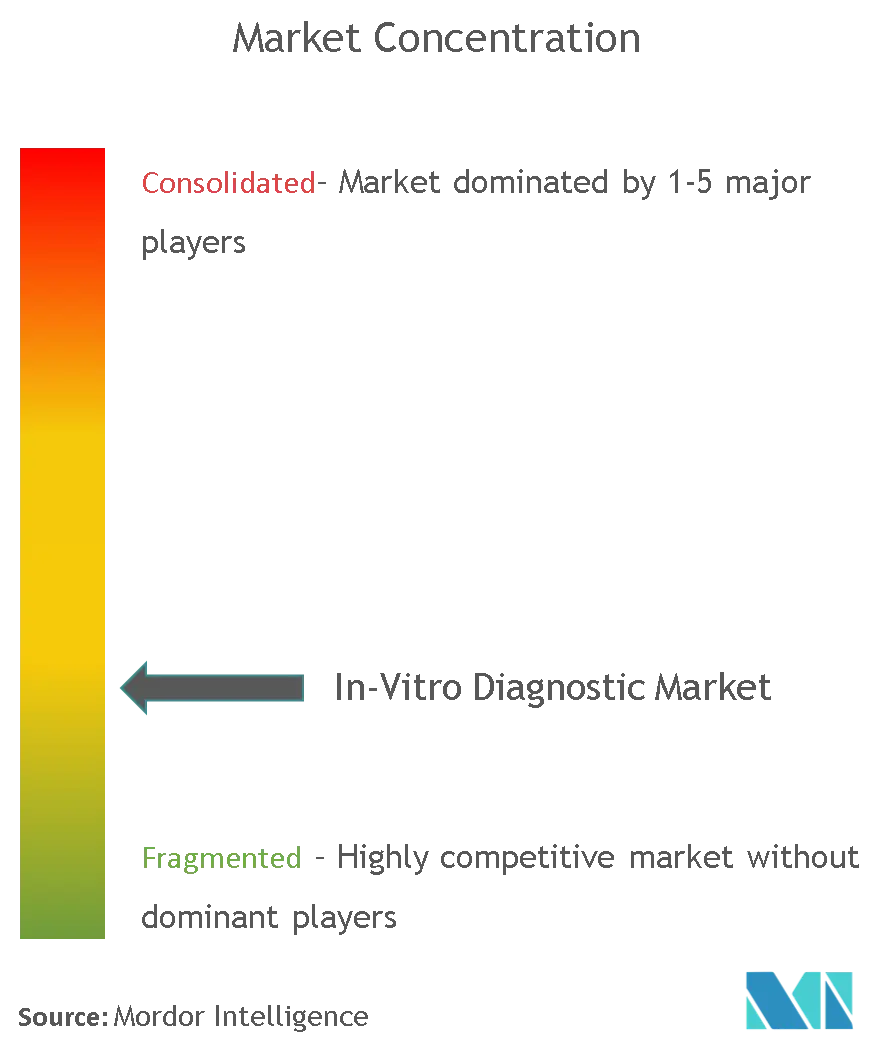
In-Vitro Diagnostic Market News
- January 2024: ELITechGroup expanded its in-vitro diagnostics product portfolio and launched the Conformite Europeenne- In Vitro Diagnostic Regulation (CE-IVDR) certified gastrointestinal (GI) bacterial PLUS ELITe MGB kit, which can target bacterial pathogens associated with gastrointestinal infections. This product portfolio expansion aims to increase the adoption of such kits for detecting bacterial pathogens associated with GI infections.
- January 2024: HORIBA Medical launched an innovative 2.0 high-throughput automated hematology platform, certified with the Conformite Europeenne- In Vitro Diagnostic Regulation (CE-IVDR), which can provide high-quality and high-throughput analytical performance in laboratories.
In Vitro Diagnostics (IVD) Market Report - Table of Contents
1. INTRODUCTION
- 1.1 Study Assumptions and Market Definition
- 1.2 Scope of the Study
2. RESEARCH METHODOLOGY
3. EXECUTIVE SUMMARY
4. MARKET DYNAMICS
- 4.1 Market Overview
-
4.2 Market Drivers
- 4.2.1 High Prevalence of Chronic Diseases
- 4.2.2 Increasing Use of Point-of-Care (POC) Diagnostics
- 4.2.3 Advanced Technologies in In-vitro Diagnostic Products
- 4.2.4 Increasing Awareness and Acceptance of Personalized Medicines and Companion Diagnostics
-
4.3 Market Restraints
- 4.3.1 Stringent Regulations Regarding Product Approvals
- 4.3.2 Cumbersome Reimbursement Procedures
-
4.4 Porter's Five Forces Analysis
- 4.4.1 Threat of New Entrants
- 4.4.2 Bargaining Power of Buyers/Consumers
- 4.4.3 Bargaining Power of Suppliers
- 4.4.4 Threat of Substitute Products
- 4.4.5 Intensity of Competitive Rivalry
5. MARKET SEGMENTATION (Market Size by Value - USD)
-
5.1 By Test Type
- 5.1.1 Clinical Chemistry
- 5.1.2 Molecular Diagnostics
- 5.1.3 Immuno Diagnostics
- 5.1.4 Hematology
- 5.1.5 Other Test Types
-
5.2 By Product
- 5.2.1 Instruments
- 5.2.2 Reagents
- 5.2.3 Other Products
-
5.3 By Usability
- 5.3.1 Disposable IVD Devices
- 5.3.2 Reusable IVD Devices
-
5.4 By Application
- 5.4.1 Infectious Disease
- 5.4.2 Diabetes
- 5.4.3 Cancer/Oncology
- 5.4.4 Cardiology
- 5.4.5 Autoimmune Disease
- 5.4.6 Nephrology
- 5.4.7 Other Applications
-
5.5 By End User
- 5.5.1 Diagnostic Laboratories
- 5.5.2 Hospitals and Clinics
- 5.5.3 Other End Users
-
5.6 Geography
- 5.6.1 North America
- 5.6.1.1 United States
- 5.6.1.2 Canada
- 5.6.1.3 Mexico
- 5.6.2 Europe
- 5.6.2.1 Germany
- 5.6.2.2 United Kingdom
- 5.6.2.3 France
- 5.6.2.4 Italy
- 5.6.2.5 Spain
- 5.6.2.6 Rest of Europe
- 5.6.3 Asia-Pacific
- 5.6.3.1 China
- 5.6.3.2 Japan
- 5.6.3.3 India
- 5.6.3.4 Australia
- 5.6.3.5 South Korea
- 5.6.3.6 Rest of Asia-Pacific
- 5.6.4 Middle East and Africa
- 5.6.4.1 GCC
- 5.6.4.2 South Africa
- 5.6.4.3 Rest of Middle East and Africa
- 5.6.5 South America
- 5.6.5.1 Brazil
- 5.6.5.2 Argentina
- 5.6.5.3 Rest of South America
6. COMPETITIVE LANDSCAPE
-
6.1 Company Profiles
- 6.1.1 BioMerieux
- 6.1.2 Danaher Corporation
- 6.1.3 F. Hoffmann-La Roche Ltd
- 6.1.4 Becton, Dickinson and Company
- 6.1.5 Bio-Rad Laboratories Inc.
- 6.1.6 Abbott
- 6.1.7 Arkray Inc.
- 6.1.8 Sysmex Corporation
- 6.1.9 Siemens Healthineers AG
- 6.1.10 Thermo Fischer Scientific Inc.
- 6.1.11 Qiagen
- 6.1.12 Grifols SA
- 6.1.13 Agilent Technologies Inc.
- 6.1.14 DiaSorin SpA
- *List Not Exhaustive
7. MARKET OPPORTUNITIES AND FUTURE TRENDS
** Subject To AvailablityIn Vitro Diagnostic Industry Segmentation
As per the scope of this industry research report, in vitro diagnostics involves medical devices and consumables that are utilized to perform in-vitro tests on various biological samples. They are used for the diagnosis of various medical conditions, such as diabetes and cancer. As detailed in industry pdf, the in vitro diagnostics market is segmented by test type, product, usability, application, end user, and geography. By test type, the market is segmented into clinical chemistry, molecular diagnostics, immunodiagnostics, hematology, and other test types. By product, the market is segmented into instruments, reagents, and other products. By usability, the market is segmented into disposable IVD devices and reusable IVD devices. By application, the market is segmented into infectious disease, diabetes, cancer/oncology, cardiology, autoimmune disease, nephrology, and other applications. By end user, the market is segmented into diagnostic laboratories, hospitals and clinics, and other end users. By geography, the market is segmented into North America, Europe, Asia-Pacific, Middle East and Africa, and South America. For each segment, the market size is provided in terms of value (USD).
| By Test Type | Clinical Chemistry | |
| Molecular Diagnostics | ||
| Immuno Diagnostics | ||
| Hematology | ||
| Other Test Types | ||
| By Product | Instruments | |
| Reagents | ||
| Other Products | ||
| By Usability | Disposable IVD Devices | |
| Reusable IVD Devices | ||
| By Application | Infectious Disease | |
| Diabetes | ||
| Cancer/Oncology | ||
| Cardiology | ||
| Autoimmune Disease | ||
| Nephrology | ||
| Other Applications | ||
| By End User | Diagnostic Laboratories | |
| Hospitals and Clinics | ||
| Other End Users | ||
| Geography | North America | United States |
| Canada | ||
| Mexico | ||
| Geography | Europe | Germany |
| United Kingdom | ||
| France | ||
| Italy | ||
| Spain | ||
| Rest of Europe | ||
| Geography | Asia-Pacific | China |
| Japan | ||
| India | ||
| Australia | ||
| South Korea | ||
| Rest of Asia-Pacific | ||
| Geography | Middle East and Africa | GCC |
| South Africa | ||
| Rest of Middle East and Africa | ||
| Geography | South America | Brazil |
| Argentina | ||
| Rest of South America |
In Vitro Diagnostics (IVD) Market Research FAQs
How big is the In Vitro Diagnostic Market?
The In Vitro Diagnostic Market size is expected to reach USD 95.59 billion in 2024 and grow at a CAGR of 5.62% to reach USD 125.61 billion by 2029.
What is the current In Vitro Diagnostic Market size?
In 2024, the In Vitro Diagnostic Market size is expected to reach USD 95.59 billion.
Who are the key players in In Vitro Diagnostic Market?
F. Hoffmann-La Roche Ltd, Thermo Fischer Scientific Inc, Abbott, Siemens Healthineers AG and Biomerieux are the major companies operating in the In Vitro Diagnostic Market.
Which is the fastest growing region in In Vitro Diagnostic Market?
Asia Pacific is estimated to grow at the highest CAGR over the forecast period (2024-2029).
Which region has the biggest share in In Vitro Diagnostic Market?
In 2024, the North America accounts for the largest market share in In Vitro Diagnostic Market.
What years does this In Vitro Diagnostic Market cover, and what was the market size in 2023?
In 2023, the In Vitro Diagnostic Market size was estimated at USD 90.22 billion. The report covers the In Vitro Diagnostic Market historical market size for years: 2021, 2022 and 2023. The report also forecasts the In Vitro Diagnostic Market size for years: 2024, 2025, 2026, 2027, 2028 and 2029.
What are the market drivers for IVD?
The Market Drivers for IVD are a) Continuous advancements in diagnostic technologies, such as molecular diagnostics, immunoassays, and point-of-care testing b) Increasing demand for rapid and on-site testing solutions
What are the trends in the In-vitro Diagnostics Market?
The trends in the In-vitro Diagnostics Market are a) Surging demand for reagents used in the various testing platforms b) Advanced scientific and technological capabilities in molecular diagnostics
What are the market drivers for IVD?
The Market Drivers for IVD are a) Continuous advancements in diagnostic technologies, such as molecular diagnostics, immunoassays, and point-of-care testing b) Increasing demand for rapid and on-site testing solutions
In Vitro Diagnostics Industry Report
This comprehensive market research report offers a deep dive into the in-vitro diagnostics industry, providing a detailed analysis of key market drivers, market statistics and market segments. Mordor Intelligence offers customization based on your specific interests, including: 1. Service: Data Management & Software 2. Technology: Urinalysis, Coagulation, Hemostasis, Tissue Diagnostics 3. Application: Gastrointestinal Diseases, Nephrological Diseases 4. Test Location: Point of Care (PoC), Homecare. Adding to this, our annual report also provides a deeper dive into the industry forecast and market trend, refer to Mordor Intelligence™ Market Reports, for detailed analysis on market value available in a free report PDF download.



